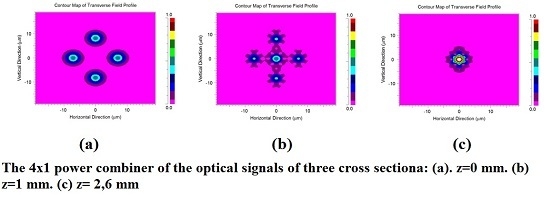Design of 4 × 1 Power Beam Combiner Based on MultiCore Photonic Crystal Fiber
Abstract
:Featured Application
Abstract
1. Introduction
2. Principle of the Work
3. Results: The Designs of 4 × 1 and 8 × 1 Power Combiners
4. Simulation Results
5. Conclusions
Author Contributions
Conflicts of Interest
References
- Snitzer, E. Optical maser action of Nd+3 in a barium crown glass. Phys. Rev. Lett. 1961, 7, 444–446. [Google Scholar] [CrossRef]
- Snitzer, E.; Hoffman, F.; Crevier, R. Neodymium-glass-fiber laser. J. Opt. Soc. Am. 1963, 53, 515–517. [Google Scholar]
- Je, G.; Malka, D.; Kim, H.; Hong, S.; Shin, B. A study on micro hydroforming using shock wave of 355 nm UV-pulsed laser. Appl. Surf. Sci. 2017, 417, 244–249. [Google Scholar] [CrossRef]
- Ushenko, Y.A.; Arkhelyuk, A.D.; Sidor, M.I.; Bachynskyi, V.T.; Wanchuliak, O.Y. Laser polarization autofluorescence of endogenous porphyrins of optically anisotropic biological tissues and fluids in diagnostics of necrotic and pathological changes of human organs. Appl. Opt. 2014, 53, B181–B191. [Google Scholar] [CrossRef] [PubMed]
- Ding, D.; Lv, X.; Chen, X.; Wang, F.; Zhang, J.; Che, K. Tunable high-power blue external cavity semiconductor laser. Opt. Laser Technol. 2017, 94, 1–5. [Google Scholar] [CrossRef]
- Jones, T.B.; Otterstrom, N.; Jackson, J.; Archibald, J.; Durfee, D.S. Laser wavelength metrology with color sensor chips. Opt. Express 2015, 23, 32471–32480. [Google Scholar] [CrossRef] [PubMed]
- Wang, Y.; Wang, Y.; Le, H.Q. Multi-spectral mid-infrared laser stand-off imaging. Opt. Express 2005, 13, 6572–6586. [Google Scholar] [CrossRef] [PubMed]
- Yahel, E.; Hardy, A. Modeling High-Power Er3+-Yb3+ Codoped Fiber Lasers. J. Lightwave Technol. 2003, 21, 2044. [Google Scholar] [CrossRef]
- Vienne, G.G.; Caplen, J.E.; Dong, L.; Minelly, J.D.; Nilsson, J.; Payne, D.N. Fabrication and Characterization of Yb3+: Er3+ Phosphosilicate Fibers for Lasers. J. Lightwave Technol. 1998, 16, 1990. [Google Scholar] [CrossRef]
- Stiles, E. New developments in IPG fiber laser technology. In Proceedings of the 5th International Workshop on Fiber Lasers, Dresden, Germany, 30 September–1 October 2009. [Google Scholar]
- Dawson, J.W.; Messerly, J.M.; Beach, R.J.; Shverdin, M.Y.; Stappaerts, E.A.; Sridharan, A.K.; Pax, P.H.; Heebner, J.E.; Siders, C.W.; Barty, C.P.J. Analysis of the scalability of diffraction-limited fiber lasers and amplifiers. Opt. Express 2008, 16, 13240–13266. [Google Scholar] [CrossRef]
- Liu, Z.; Zhou, P.; Xu, X.; Wang, X.; Ma, Y. Coherent beam combining of high power fiber lasers: Progress and prospect. Sci. China Technol. Sci. 2013, 56. [Google Scholar] [CrossRef]
- Drachenberg, D.; Divliansky, I.; Smirnov, V.; Venus, G.; Glebov, L. High Power Spectral Beam Combining of Fiber Lasers with Ultra High Spectral Density by Thermal Tuning of Volume Bragg Gratings. In SPIE: Fiber Lasers VIII: Technology, Systems, and Applications, San Francisco, CA, USA, 22 January 2011; SPIE: Bellingham, WA, USA, 2011; Volume 7914, p. 79141F. [Google Scholar]
- Shamir, Y.; Zuitlin, R.; Sintov, Y.; Shtaif, M. High brightness efficient beam combining of 3 kW 1.07 μm fiber lasers with very low thermal dissipation. In Proceedings of the OASIS, Meeting on Optical Engineering and Science, Tel Aviv, Israel, 19–20 February 2013. [Google Scholar]
- Russell, P.S.J. Photonic-crystal fibers. J. Lightwave Technol. 2006, 24, 4729–4749. [Google Scholar] [CrossRef]
- Broeng, J.; Mogilevstev, D.; Barkou, S.E.; Bjarklev, A. Photonic crystal fibers: A new class of optical waveguides. Opt. Fiber Technol. 1999, 5, 305–330. [Google Scholar] [CrossRef]
- Elbaz, D.; Malka, D.; Zalevsky, Z. Photonic crystal fiber based 1 × N intensity and wavelength splitters/couplers. Electromagnetics 2013, 32, 209–220. [Google Scholar] [CrossRef]
- Malka, D.; Zalevsky, Z. Multicore Photonic Crystal Fiber Based 1 × 8 Two-Dimensional Intensity Splitters/Couplers. Electromagnetics 2013, 33, 413–420. [Google Scholar] [CrossRef]
- Malka, D.; Peled, A. Power Splitting of 1 × 16 in Multicore Photonic Crystal Fibers. Appl. Surf. Sci. 2017, 417, 34–39. [Google Scholar] [CrossRef]
- Malka, D.; Sintov, Y.; Zalevsky, Z. Fiber-laser monolithic coherent beam combiner based on multicore photonic crystal fiber. Opt. Eng. 2014, 54, 011007. [Google Scholar] [CrossRef]
- Mortimore, D.B. Theory and fabrication of 4 × 4 single-mode fused optical fiber couplers. Appl. Opt. 1990, 29, 371–374. [Google Scholar] [CrossRef] [PubMed]
- Kumar, A.; Varshney, R.K.; Sinha, R.K. Scalar modes and coupling characteristics of eight-port waveguide couplers. J. Lightwave Technol. 1989, 7, 293–296. [Google Scholar] [CrossRef]
- Mortimore, D.B.; Arkwright, J.W. Monolithic wavelength-falt-tened 1 × 7 single-mode fused fiber couplers: Theory, fabrication and analysis. Appl. Opt. 1991, 30, 650–659. [Google Scholar] [CrossRef] [PubMed]
- Haus, H.A.; Huang, W. Coupled-Mode Theory. Proc. IEEE 1991, 79, 1505–1517. [Google Scholar] [CrossRef]
- Katz, O.; Malka, D. Design of novel SOI 1 × 4 optical power splitter using seven horizontally slotted waveguides. Photonics Nanostruct. Fundam. Appl. 2017, 25, 9–13. [Google Scholar] [CrossRef]
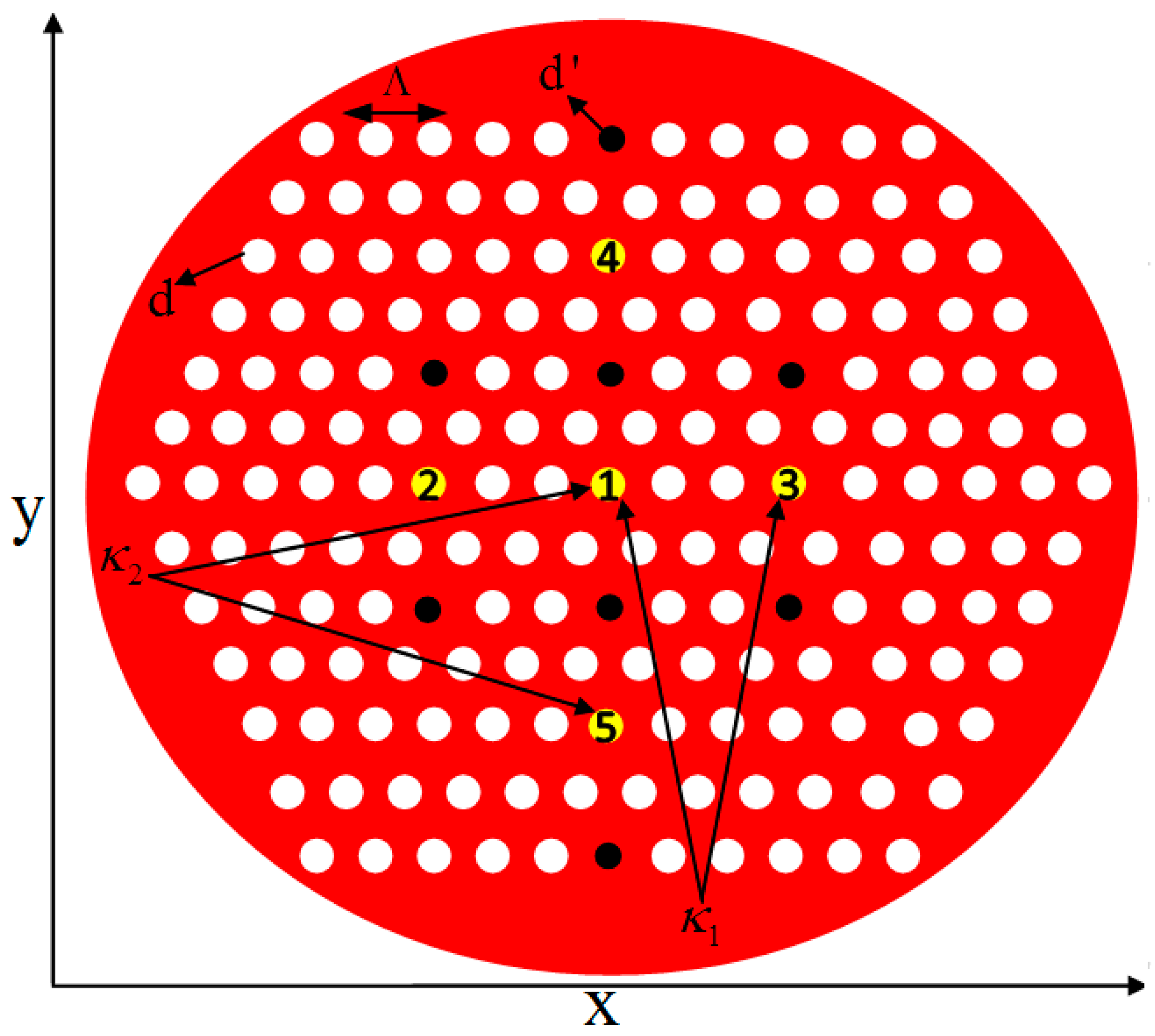
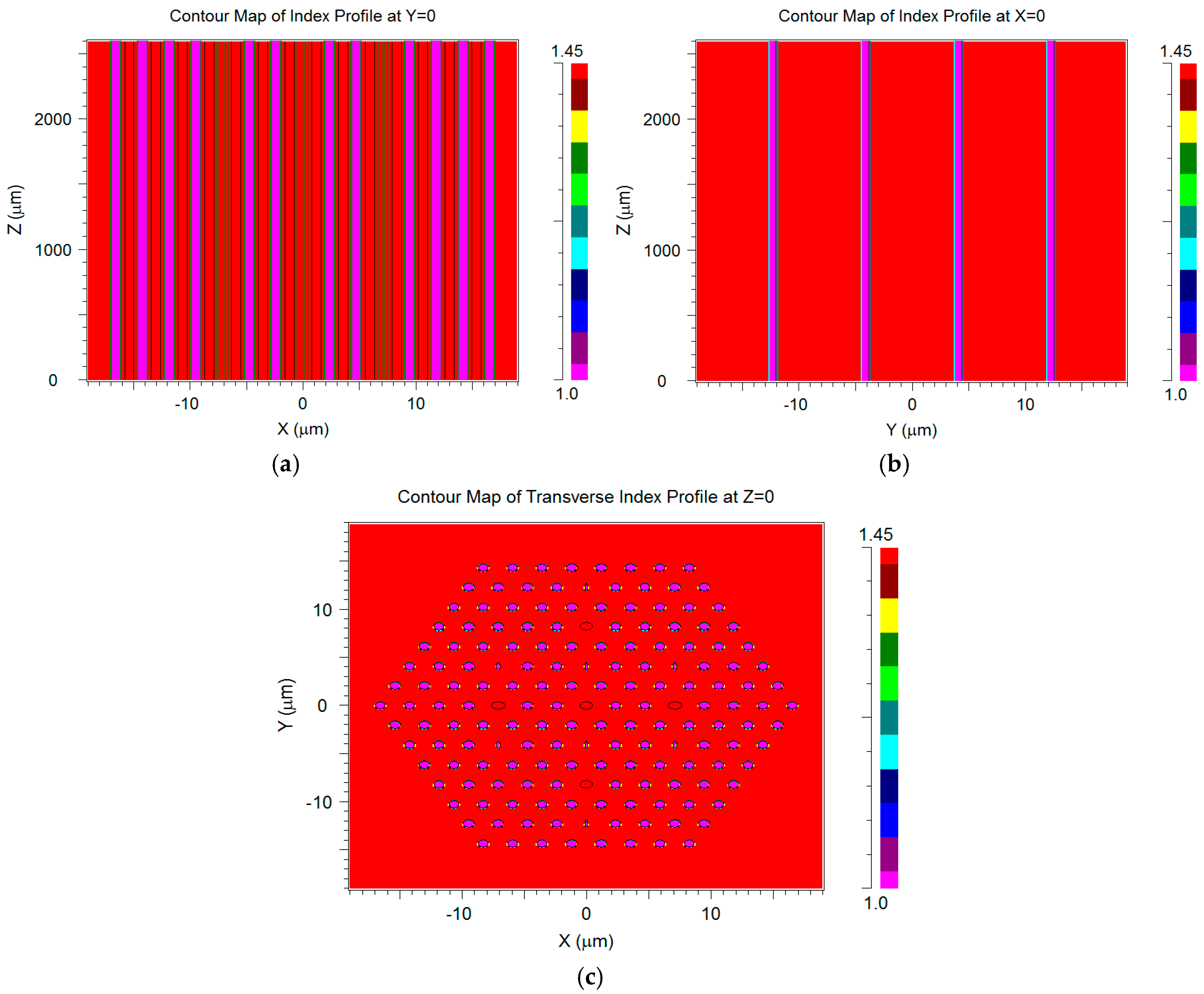
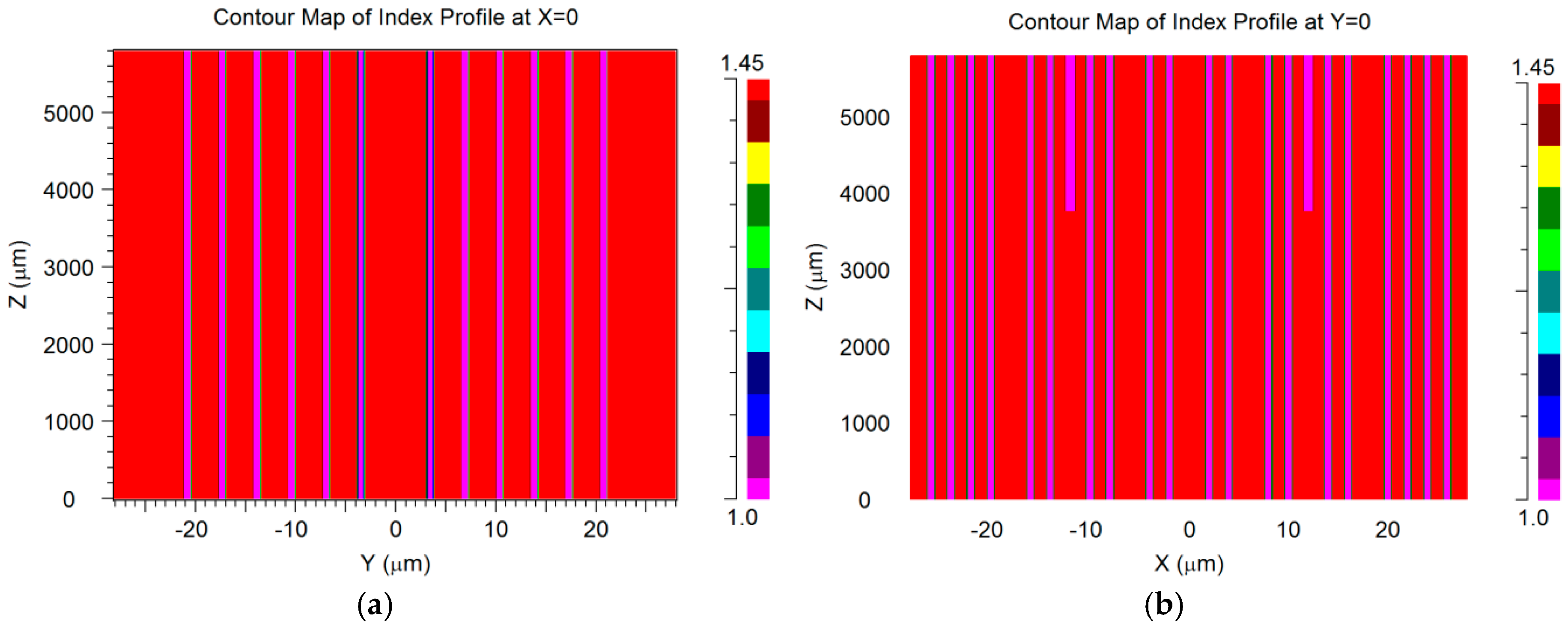
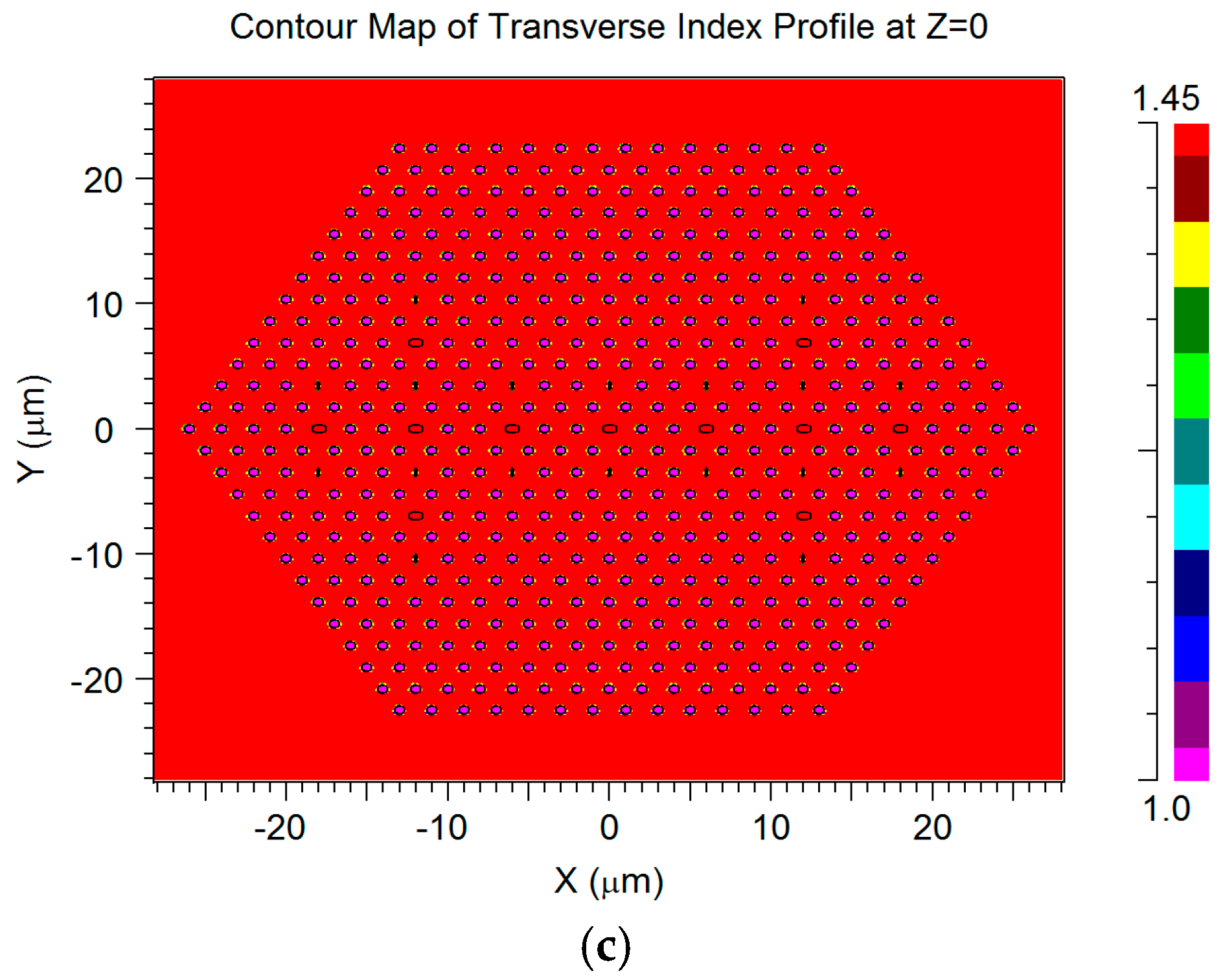
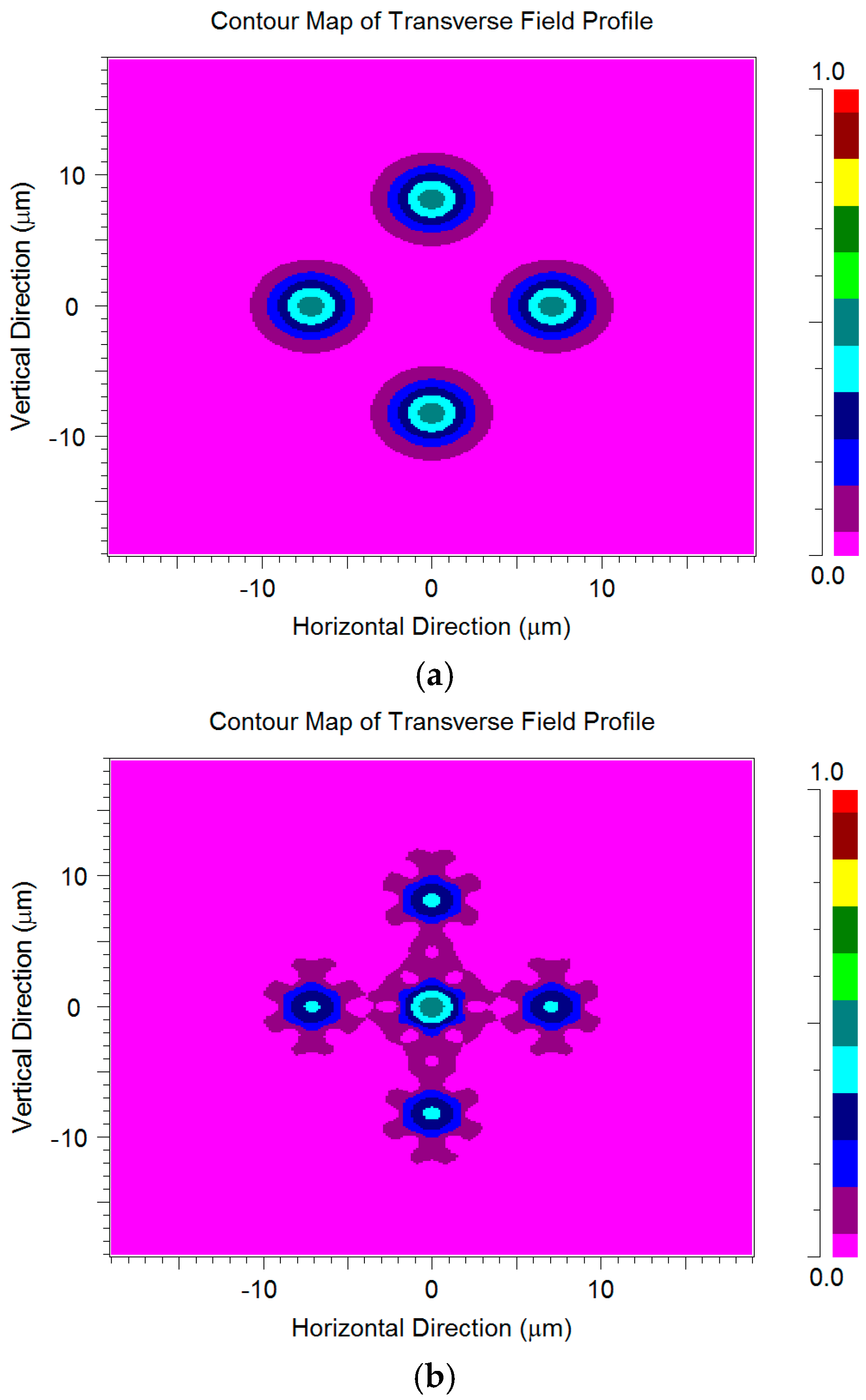
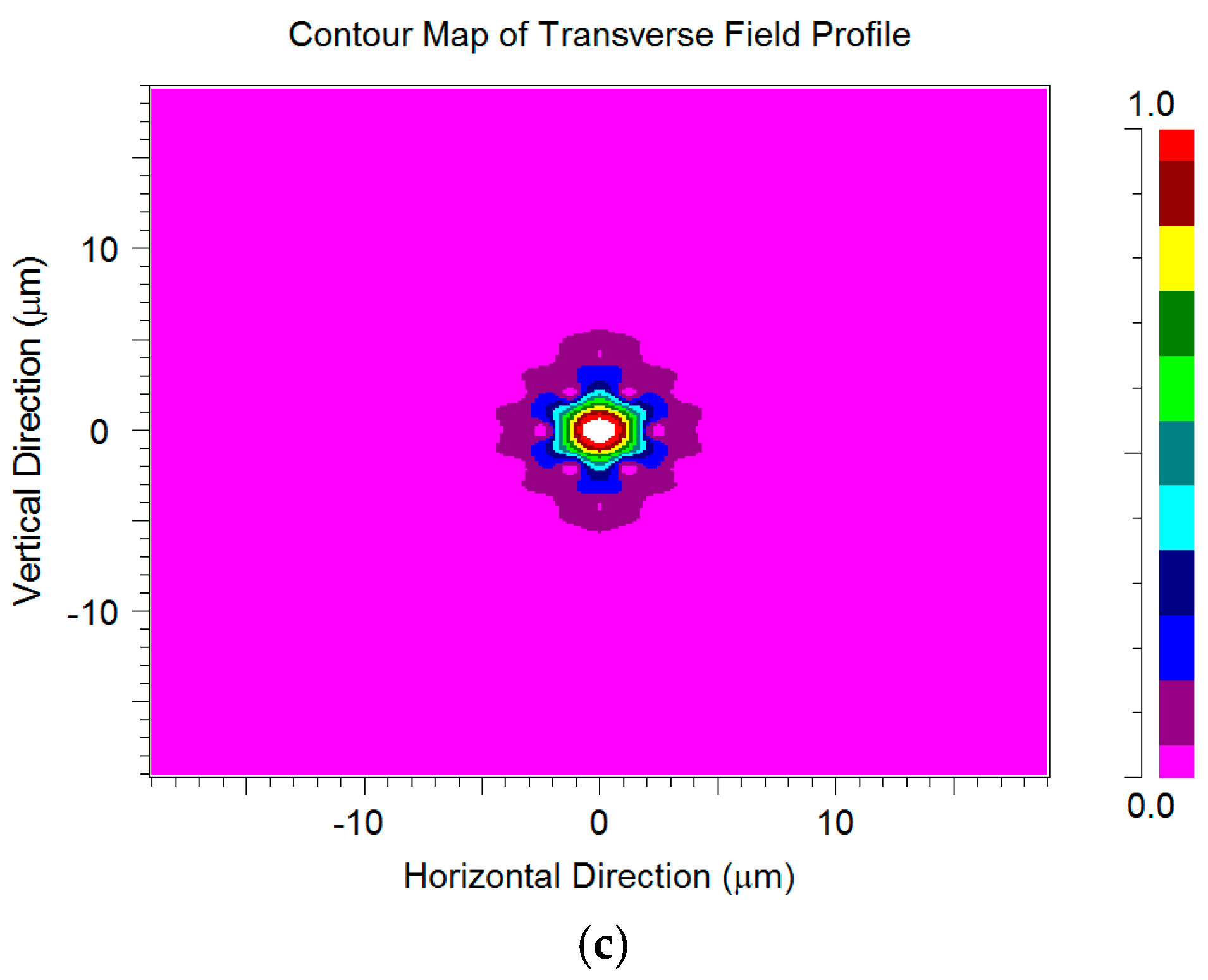
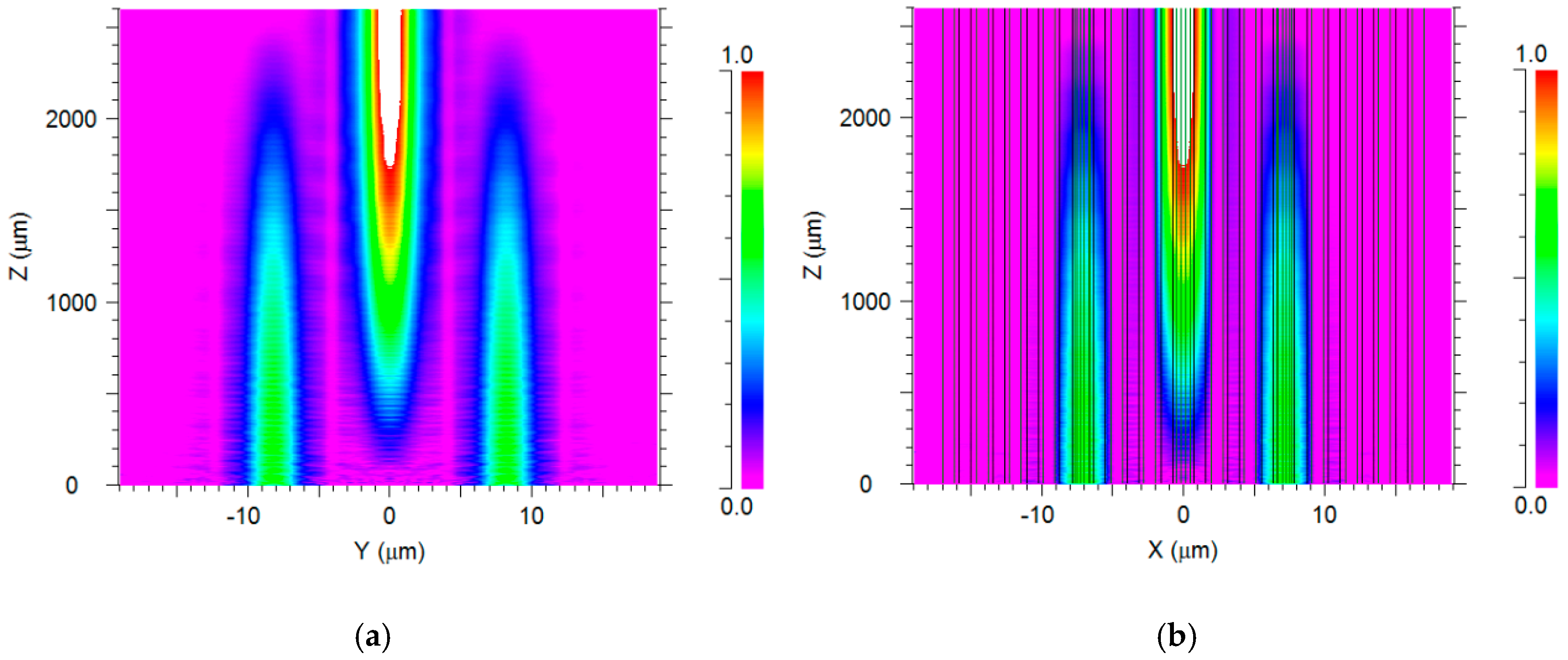
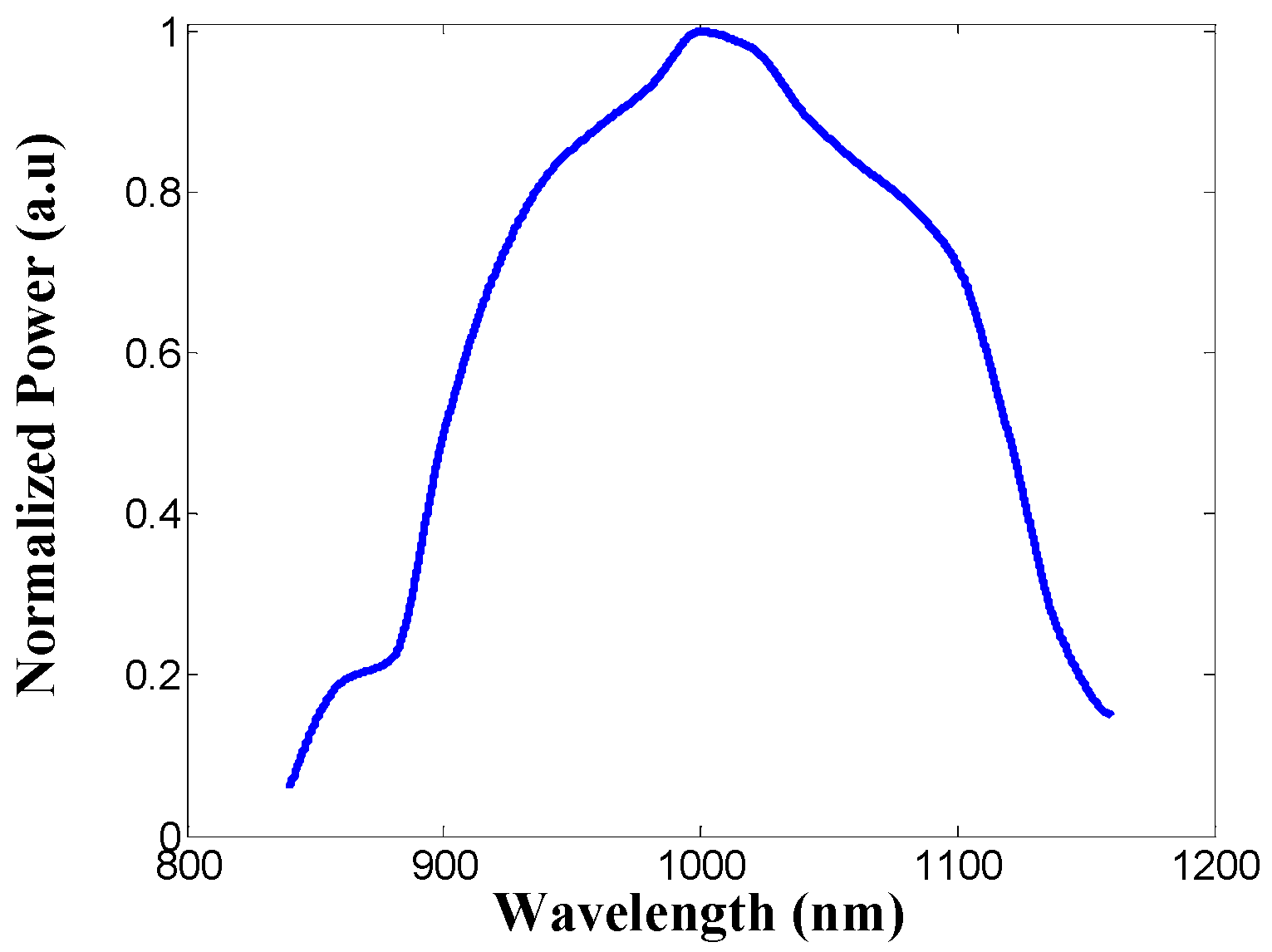
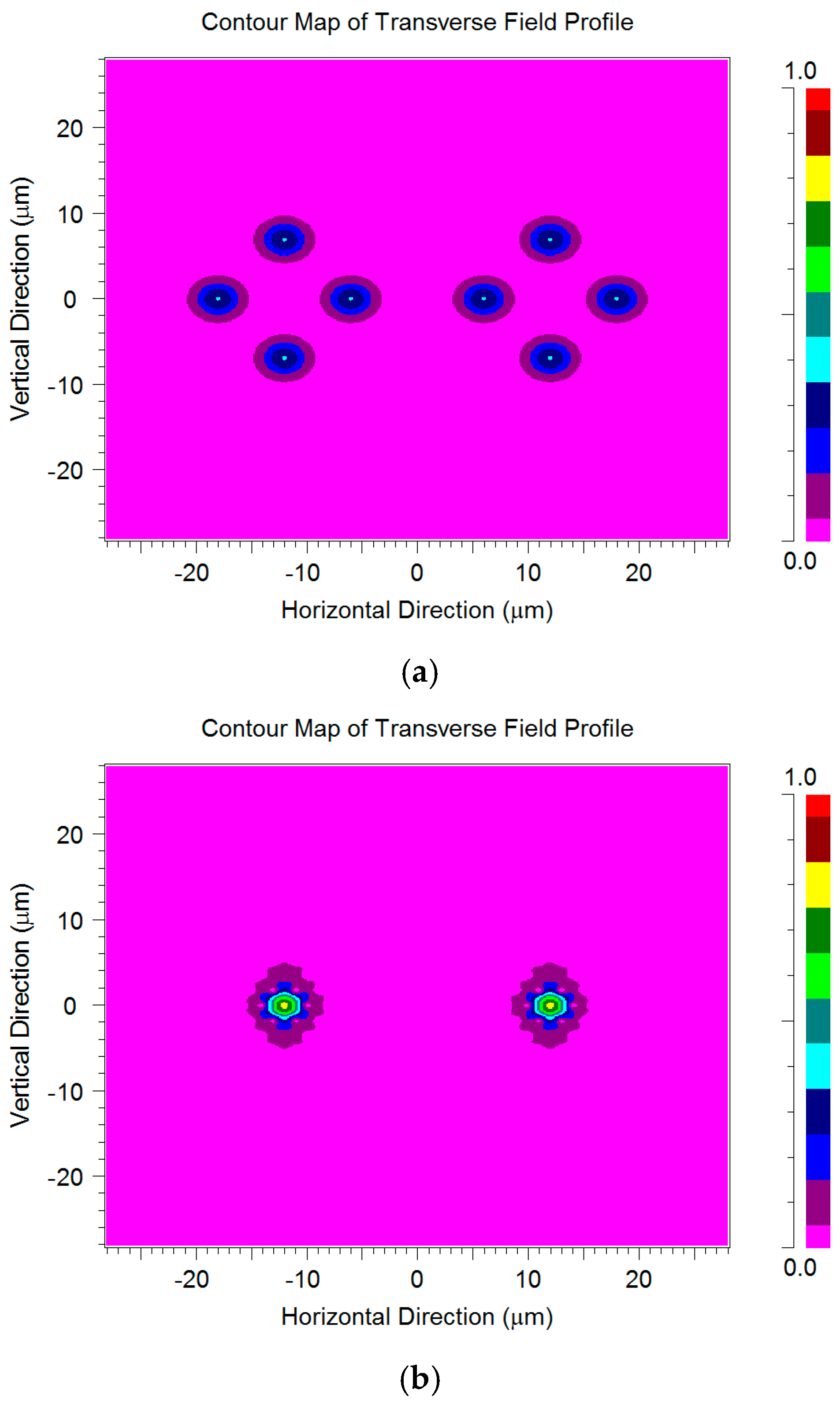
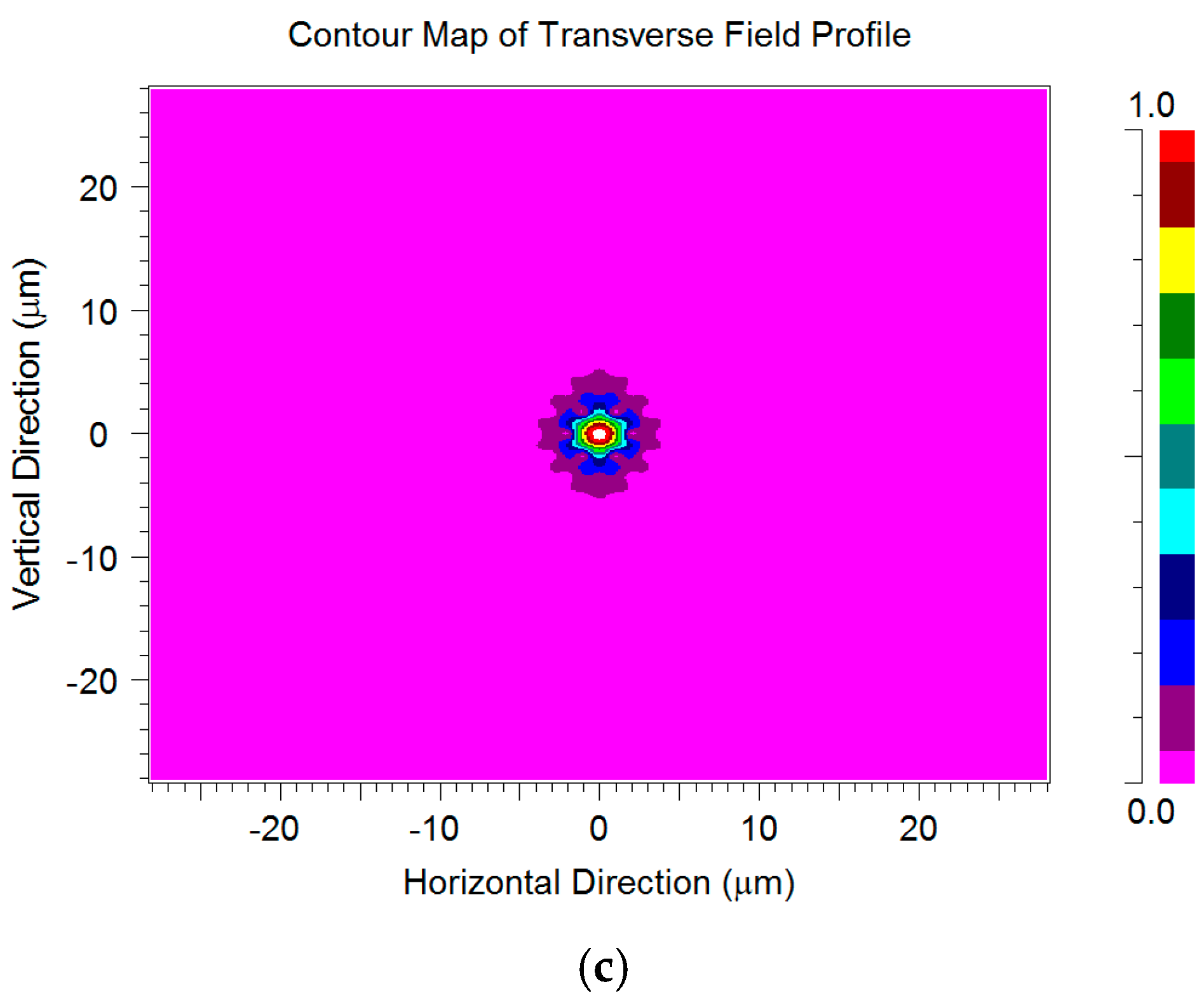
© 2017 by the authors. Licensee MDPI, Basel, Switzerland. This article is an open access article distributed under the terms and conditions of the Creative Commons Attribution (CC BY) license (http://creativecommons.org/licenses/by/4.0/).
Share and Cite
Malka, D.; Cohen, E.; Zalevsky, Z. Design of 4 × 1 Power Beam Combiner Based on MultiCore Photonic Crystal Fiber. Appl. Sci. 2017, 7, 695. https://doi.org/10.3390/app7070695
Malka D, Cohen E, Zalevsky Z. Design of 4 × 1 Power Beam Combiner Based on MultiCore Photonic Crystal Fiber. Applied Sciences. 2017; 7(7):695. https://doi.org/10.3390/app7070695
Chicago/Turabian StyleMalka, Dror, Eyal Cohen, and Zeev Zalevsky. 2017. "Design of 4 × 1 Power Beam Combiner Based on MultiCore Photonic Crystal Fiber" Applied Sciences 7, no. 7: 695. https://doi.org/10.3390/app7070695




